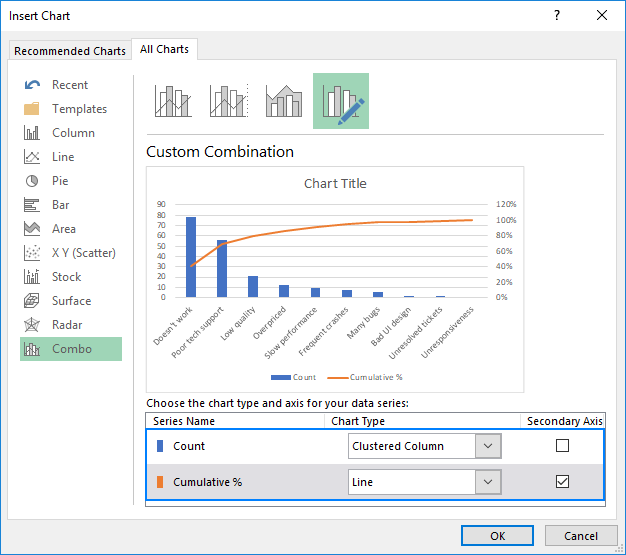

#How to create a pareto chart in excel 2013 how to
I’m here to walk you through the steps to get your data prepped for a Pareto chart then how to create the chart itself. This chart is useful for prioritizing and sorting data. They are unique because they typically have one horizontal axis (the x-axis) and two vertical axes.

Pareto charts are a combination of a line graph and a bar graph. Using a Pareto chart in Microsoft Excel could have sped the process up for you considerably. Not only have you figured out how to help your team, you’ve just performed a Pareto analysis.īut all that paperwork probably took you some time. You realize that by fixing the communication problem you can eliminate a huge percentage of the problems, and by fixing the resource access problems you can clear nearly 90% of the team’s hurdles. Other issues drop into the single digits. In looking at the numbers, you discover that lack of communication between the project workers and the project stakeholders is the root cause of 23 of the main problems the team faces, while the next largest issue, access to necessary resources (computer systems, equipment, etc.), scored only an 11. You apply a ranking to each problem cause based on the frequency that it occurs. They make the list, and you analyze it to figure out what the root causes are for each of the problems are that they are experiencing, looking for commonalities. You ask the team members what their main obstacles have been in terms of meeting objectives and expectations. This can be valuable, even vital information when you are trying to figure out which of many problems to tackle first, or in a complicated troubleshooting environment.įor example, you have just been asked to lead a struggling project team to get them back on track. The Pareto Principle, named for Italian economist Vilfredo Pareto, suggests that 80% of problems can be traced to as few as 20% of root causes. By Excel Tips and Tricks from Categories: Charts Tags: Pareto Chart


 0 kommentar(er)
0 kommentar(er)
